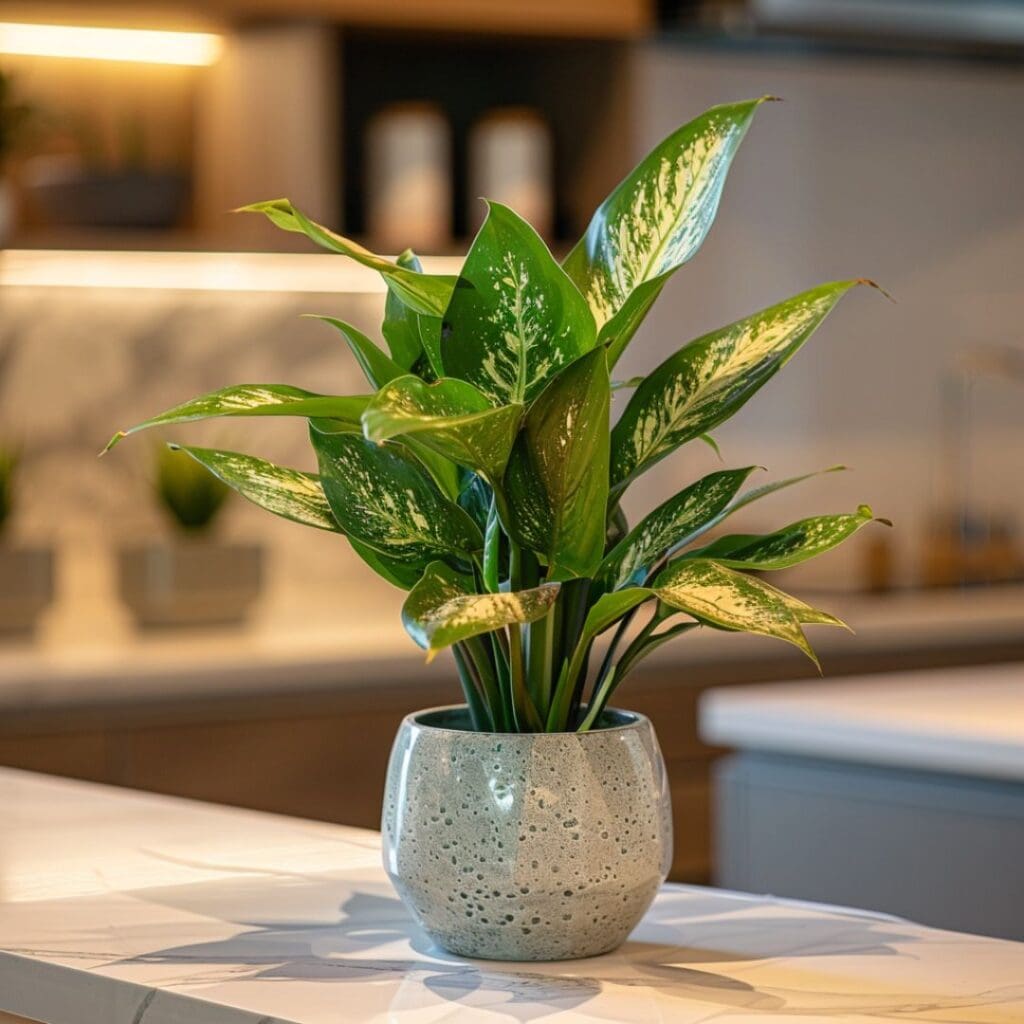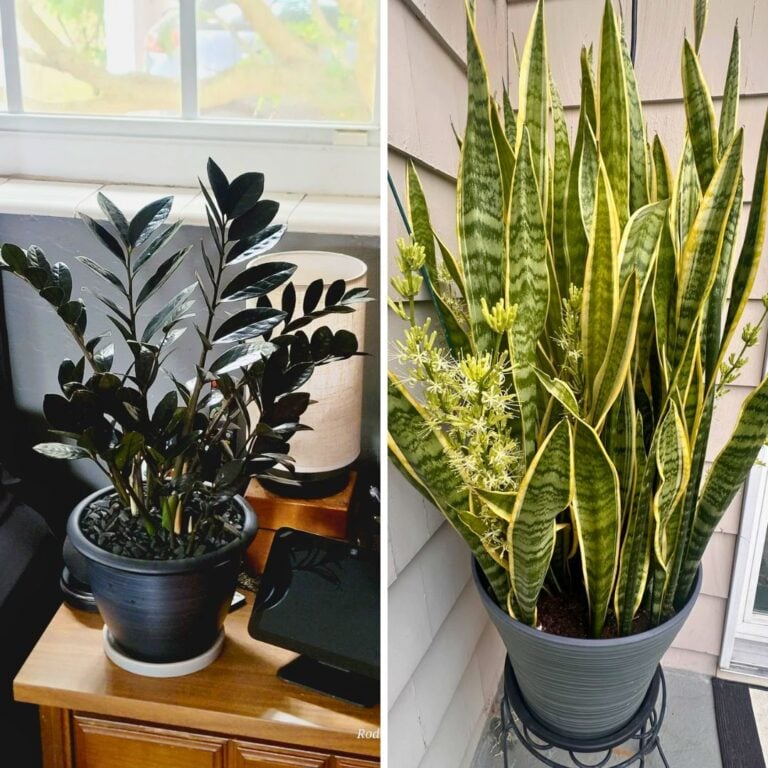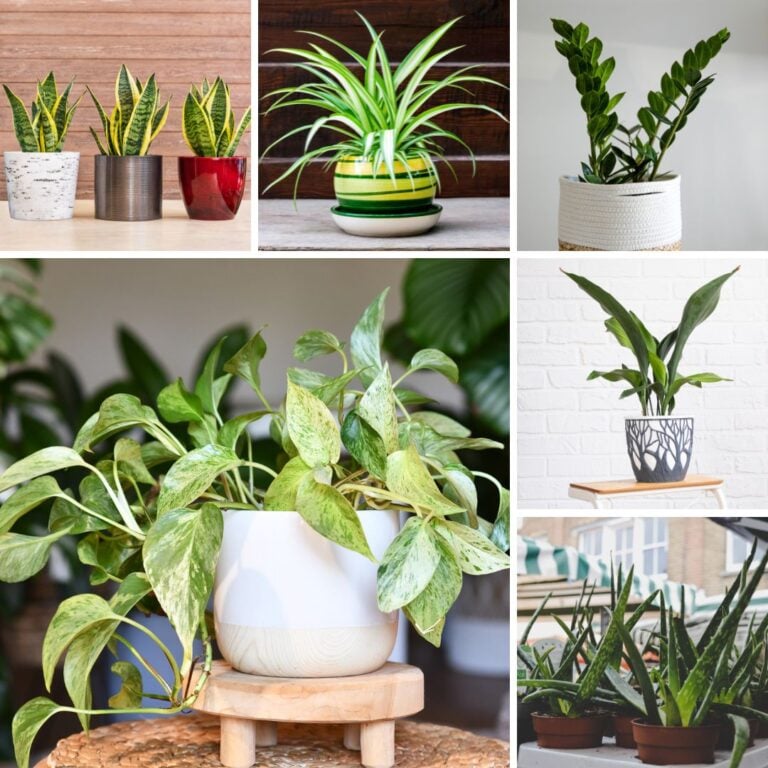7 Indoor Plants That Still Look Fresh Without Flowers
I really enjoy having plants around, but honestly, flowers can be a bit much sometimes. They need extra attention and, let’s face it, they fade way too fast.
I’ve noticed that some indoor plants look just as lively and inviting, even without any blooms.
Their leaves alone can make a room feel calm and bright, almost like they’re quietly cheering up the space.
Please note: Simplify Plants is reader-supported. As an Amazon Associate, I earn from qualifying purchases made by our readers with no extra cost added to you all! Some links in the post are affiliate links and I get a commission from purchases made through links in the post.
1) Snake Plant (Sansevieria)

I keep a Snake Plant at home mostly because it’s so easy to care for. Those tall, upright leaves with green and yellow patterns look bold and fresh, even without any flowers.
It’s perfect if you forget to water sometimes (guilty here). Snake Plants are tough and can go for weeks without water, so I just give mine a drink every couple of weeks.
This plant seems happy in almost any spot. It’ll survive in low light, but it can handle brighter places too. That flexibility is a lifesaver if you live in an apartment or have rooms with not much sunlight.
The thick leaves stay green all year. I barely have to do anything, and it still looks good.
Snake Plants also help clean the air—which feels like a bonus. I like knowing it’s doing a little work for me.
Those upright, sword-like leaves always grab attention. I move mine around from the floor to a shelf, and it never looks out of place.
If you want something that pretty much takes care of itself, this is the one. Even if you’re busy, it’s hard to mess up with a Snake Plant.
2) ZZ Plant (Zamioculcas zamiifolia)

The ZZ Plant is easily one of my favorites for low-maintenance greenery. It’s got thick, glossy leaves that catch the light and always look healthy, even if I forget to water it.
I love that it barely needs any light. It’ll grow in low-light corners where most plants would just give up. Mine lives on a shelf away from the window and still pushes out new leaves.
This plant is just tough and easy. Sometimes I forget about it for a week or more, but it keeps its deep green shine.
Dust does build up on those waxy leaves sometimes. I just wipe them down every few weeks, and it looks shiny again. A quick dusting really helps.
My favorite thing is how the ZZ Plant makes a room feel a bit more alive. Upright stems and bold leaves—no flowers needed. It’s honestly great if you’re busy or just not super attentive.
I’d say it’s a great choice for beginners or anyone who wants a plant that looks fresh year-round. It’s common in offices and homes since it tolerates dry air and doesn’t mind being ignored for a while.
If you have pets, just a heads-up—the ZZ Plant isn’t safe for cats or dogs to chew on. Keep it out of reach.
My ZZ Plant has been a solid, attractive addition to my space. If you want green leaves that always look their best, the ZZ Plant is hard to beat.
3) Pothos (Epipremnum aureum)

When I think of easy houseplants, Pothos pops up first. Those bright, heart-shaped leaves always look good, no flowers required.
Pothos will put up with a lot. I’ve grown it in low light and in brighter spots, and it just keeps going. It’s forgiving if you forget to water sometimes, which is a relief.
One thing I love is how the vines grow long and trail off shelves or baskets. I’ll drape a vine around a window or just let it hang wherever. The leaves grow faster with a bit more sunlight and regular water.
Pothos comes in several varieties. Some have yellow or white streaks, others are just a deep green. The different patterns make each one feel a little special.
If you want to share your plant, Pothos is super easy to propagate. Just snip a piece, put it in water, and roots show up before you know it. It’s fun to give new plants to friends or just fill your own place with more green.
It helps clean the air a bit, too. I know it won’t filter everything, but more greenery always feels fresher. It’s not picky about soil or pots, which is honestly great.
When the leaves droop, I know it’s thirsty. I also watch for yellow or brown tips—usually it means too much water or fertilizer.
Pothos is a classic for a reason. It’s pretty, grows fast, and doesn’t need much fuss.
4) Spider Plant (Chlorophytum comosum)

The Spider Plant is one of those plants that just always looks fresh. Even though it rarely flowers indoors, it keeps things bright and lively.
I like the long, narrow leaves that arch out from the center. The green with white or yellow stripes makes it look neat and a little playful.
Spider Plants are easy to care for. I just give mine some water and a spot with indirect sunlight. If I forget to water for a few days, it usually bounces right back.
They’re known for helping clean the air. I can’t see it happening, but it’s a nice thought.
I really enjoy when my Spider Plant sends out “spiderettes”—those little baby plants that hang from long stems. I can snip them off and grow more, or just let them dangle for a fuller look.
It works well in hanging baskets or regular pots. The arching leaves and baby plants keep it interesting wherever I put it.
Even though it might grow tiny white flowers sometimes, those aren’t really the point. The fresh look comes from its healthy, glossy leaves.
If you want something simple and tough that always looks good, the Spider Plant is a safe bet. I don’t have to stress to keep it looking nice.
It fits in pretty much anywhere—kitchens, bedrooms, you name it. It’s also fine with a bit of shade, which is super helpful in a small apartment.
I also appreciate that the Spider Plant is safe for pets. If my cat or dog takes a nibble, I don’t have to panic.
With easy care and graceful looks, the Spider Plant brightens up my space—no flowers needed.
5) Monstera Deliciosa

I absolutely love how Monstera Deliciosa livens up my home without a single flower. Those big, glossy leaves with natural holes make it look bold and interesting.
Monstera is pretty chill to care for. I just give it indirect sunlight and water when the top soil feels dry. It fits right into my routine, even on hectic days.
The fast growth is exciting. Every time a new leaf unfurls, it feels like a little reward. Some folks call it the “Swiss Cheese Plant” because of the holes. I think that gives it a modern vibe.
Mine is in a medium-sized pot so the leaves can get big. When it starts to grow taller, I’ll use a stake or moss pole for support.
Monstera Deliciosa is good for air quality, too. It’s nice knowing it’s helping out a bit. Plus, it looks great with pretty much any decor—modern, classic, you name it.
I wipe the leaves down with a damp cloth sometimes. Dust dulls the shine, and I like them to look extra green.
If I see yellow leaves or brown tips, I check the watering and light. Usually, it’s an easy fix.
If you’re into simple green plants, Monstera Deliciosa is a solid pick. It stands out all year, no flowers required.
6) Chinese Evergreen (Aglaonema)

The Chinese Evergreen is one of those plants that just looks good, flowers or not. Its big, shiny leaves come in green, silver, and sometimes even a bit of red.
It’s super easy to care for. It can handle low light, so I don’t stress about finding the perfect spot. Direct sun isn’t really its thing anyway.
I water it when the soil feels dry. I try not to overwater, since the roots hate sitting in water. That keeps it healthy and looking fresh.
This plant is surprisingly tough. Even if I forget about it for a while, it still looks good and keeps growing. Great for anyone new to houseplants.
It helps clean the air a bit, too. I like plants that do more than just sit there—they make the room feel nicer.
There are so many different colors and patterns, so I can always find one that fits my style. It adds beauty to my place, even if it never blooms.
7) Philodendron Brasil

I have to say, Philodendron Brasil just lights up any room the second you bring it in. Its green leaves with bold yellow stripes almost look hand-painted—seriously, who needs flowers with leaves like that?
This plant is honestly so easy to care for. It does fine in low to medium light, so I’m not scrambling to find a super sunny spot. If I forget to water it for a few days, it’s usually totally unfazed.
The vines can trail down from a shelf or hang in a basket, which adds a playful vibe to my space. I do trim the stems now and then to keep things tidy—plus, pruning makes it bushier.
If you’re new to plants, this one’s a great starter. It forgives little mistakes, so I don’t worry too much if I mess up. The leaves just keep looking fresh and lively, even when there aren’t any blooms.
Another bonus: Philodendron Brasil helps purify the air, which makes my home feel a bit cleaner. I swear, the room just looks brighter and more inviting with it around.
If I’m ever in the mood for more plants, it’s simple to take cuttings and root them in water. Watching those roots grow is pretty satisfying, honestly.
Just a heads-up—keep it away from pets, since the leaves can be toxic if eaten. Other than that, it’s a safe and rewarding pick for any indoor garden.
Philodendron Brasil brings color and life to my space without ever needing flowers. That’s why it’s always high on my list for a fresh-looking home.
Benefits Of Non-Flowering Indoor Plants
Non-flowering plants really do offer some solid perks for my home. I get cleaner air and, honestly, less hassle—so they’re a smart pick for almost any room.
Air Quality Improvement
A lot of non-flowering indoor plants actually filter and clean the air. Plants like snake plants, ferns, and peace lilies are known for removing stuff like formaldehyde, benzene, and trichloroethylene. When I keep a few around, the air just feels fresher—especially if I’ve packed a couple into one space.
Here’s a quick look at some toxins these common plants can help with:
| Plant Name | Toxins Removed |
|---|---|
| Snake Plant | Formaldehyde, Benzene, Xylene |
| Spider Plant | Carbon monoxide, Formaldehyde |
| Ferns | Toluene, Xylene |
They even add a bit of moisture to the air, which is nice if your skin gets dry or you want to breathe a little easier. I feel comfortable putting them in bedrooms, offices, you name it.
Low Maintenance Appeal
Another big plus is how low-maintenance non-flowering plants tend to be. No worrying about petals dropping or tricky light schedules. A lot of these plants survive just fine with less water and adapt to lower light, which is a lifesaver on busy days.
Take the snake plant—it only needs watering every few weeks. ZZ plants can handle barely any sunlight. And with no flowers, there’s less chance of pests showing up. That just means less cleaning and more time to actually enjoy my space.
When I go for non-flowering plants, my home stays green and lively year-round, and I don’t have to put in much extra effort.
Tips For Keeping Indoor Plants Lush And Vibrant
I always want my indoor plants to look their best—healthy, vibrant, just… happy. The trick is paying attention to a few key things about their care and environment.
Optimal Lighting
Light really is everything for plant health. I try to put my plants near windows that get plenty of indirect sunlight. Most of them don’t love harsh, direct sun since it can scorch the leaves. If a room’s too dark, my plants get sluggish and lose their color.
South-facing windows are usually the sunniest, but east or west-facing ones work well too. Sometimes I’ll use sheer curtains to soften the light, or just move the plants a bit farther from the window.
If there’s not enough natural light, I’ll turn on a grow light for a few hours. Rotating the pots every week helps keep them growing evenly instead of leaning all in one direction.
Proper Watering Practices
Watering can be a bit of a guessing game, but I’ve picked up some tricks. I always check the top inch of soil with my finger—if it’s dry, it’s watering time. If it still feels damp, I just wait.
Honestly, overwatering is way more common than underwatering. I try to err on the dry side for most plants. Good drainage is a must, so I make sure my pots have holes at the bottom. Letting water pool around the roots is just asking for root rot.
I use a small watering can with a narrow spout, so I can water the soil directly and avoid splashing the leaves. For some of my tropical plants, I’ll mist their leaves with a spray bottle a few times a week for that extra humidity.
Temperature And Humidity Control
Most of my indoor plants do best when the temperature stays between 65 and 75°F (18-24°C) during the day. I try to keep them away from cold drafts or sudden changes, since that can stress them out fast.
Humidity matters too. In winter, I’ll run a small humidifier when the heater dries out the air, or I’ll group my plants together so they help each other out. Some, like ficus and ferns, really thrive with more humidity.
If the air gets dry, I sometimes put a tray of water with pebbles under the pots. As it evaporates, it naturally boosts the humidity around the plants. Checking for brown leaf tips helps me catch problems before they get worse.
Frequently Asked Questions
People ask me all the time about the best houseplants for rooms with little sunlight. Some are great for bathrooms or dark corners, and a few can even grow pretty big without much light.
What are some popular indoor plants that thrive in low light conditions?
Snake Plant and ZZ Plant are two of my go-tos. They stay green and look fresh even in shady spots. Pothos and Spider Plants are great picks too if your room’s a bit dim.
Can you recommend large plants ideal for indoors with minimal sunlight?
Monstera Deliciosa is a solid choice. Its big leaves make a statement, for sure. The ZZ Plant can get pretty tall over time and doesn’t mind the shade at all.
What are the best small plants to grow in a bathroom with no natural light?
I’d go with Pothos and Spider Plant for windowless bathrooms. They handle low-light conditions well and still look good. You can even hang a cutting of Pothos in water—super easy.
Which hanging plants would survive in a bathroom without direct sunlight?
Pothos is a champ as a hanging plant and doesn’t need much light. Spider Plant works too, and those arching leaves really brighten up any bathroom.
Could you list some easy-to-care-for indoor plants that require little light?
Snake Plant, ZZ Plant, and Pothos are all super easy. I just water them when the soil dries out, and that’s pretty much it.
Are there any outdoor plants that can survive indoors with very little light?
Some ferns and Spider Plants actually handle the shift from outdoors to low-light indoor spaces pretty well. I usually keep their soil just a bit damp, and, honestly, I try to keep them away from any cold drafts.
Recommended Garden Supplies
| Product Image | Our Recommended Gardening Supplies | Check Offers! |
|---|---|---|
Top Top
Top
Top
Top
Top
Top
Top
Top | rePotme Houseplant and Tropical Classic Potting Soil Mix | Check Offer On Amazon |
 Top
Top
Top
Top
Top
Top
Top
Top | Espoma Organic Indoor Plant Food | Check Offer On Amazon |
 Top
Top
Top
Top
Top
Top
Top
Top | GooingTop LED Grow Light 6000K Full Spectrum Clip Plant Growing Lamp | Check Offer On Amazon |
 Top
Top
Top
Top
Top
Top
Top
Top | Soil Moisture Meter | Check Offer On Amazon |
 Top
Top
Top
Top
Top
Top
Top
Top | Govee Hygrometer Thermometer, Bluetooth Enabled! | Check Offer On Amazon |
 Top
Top | LEVOIT Humidifiers for Large Room(Best For Plants) | Check Offer On Amazon |
 Top
Top
Top
Top
Top
Top
Top
Top | Upgraded DIY Automatic Drip Irrigation Kit, 15 Potted Houseplants Support | Check Offer On Amazon |
 Top
Top
Top
Top
Top
Top
Top
Top | Stainless Steel Heavy Duty Gardening Tool Set | Check Offer On Amazon |
 Top
Top
Top
Top
Top
Top
Top
Top | Bonide Insecticidal Soap | Check Offer On Amazon |
 Top
Top
Top
Top
Top
Top
Top
Top | Bonide 32 oz Spray Neem Oil for Organic Gardening | Check Offer On Amazon |
 Top
Top
Top
Top
Top
Top
Top
Top | Garden Safe Fungicide | Check Offer On Amazon |






